Voices of Experience
Stephanie Birdsall
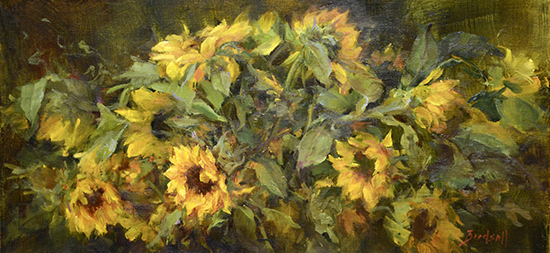
Sunflowers 10 x 20″ Oil
“I often think of light as the melody
leading us through the painting.”
Growing up surrounded by a family fluent in music and art, Stephanie Birdsall has always known she is an artist. She writes, “There has never really been anything I wanted to do, other than paint.” Now an accomplished and award-winning artist working in both pastel and oil, Birdsall wrote to us about her guiding mentors through her artistic journey and the joy of being able to teach her own students in person once again.
![]()
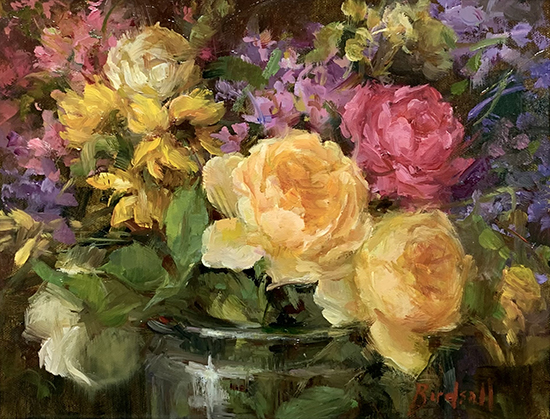
The Gift 11 x 14″ Oil
I was lucky to grow up in a family that encouraged the arts. My father was a classical violinist. He played with various symphonies and led a “big band” with a jazz guitar. My mother was a decent amateur painter. My creative life started with studying piano and classical guitar. When I decided to try oil painting, I went with my mother to a local teacher in Atlanta, Georgia.
I went on to attend the City and Guilds of London Art School in London, England, because I thought I would get a traditional, formal, education in art. We did some life drawing and painting but there was very little structured teaching. It was a great life experience even though I did not really learn to paint while there.
I learned to paint by taking workshops and just putting in the hours. Being invited to become a member of the Putney Painters, founded by Richard Schmid and Nancy Guzik, had a profound effect on me. Just to be invited to join their group gave me a huge confidence boost and helped me to believe in myself. I think having someone we respect who believes in us can really push us forward.
I’ve also been lucky enough to study with David Leffel and Sherrie McGraw.
Was pastel your preliminary medium? And now, is it still your primary medium or has oil become your medium of choice?
I remember my father took me to an art store and bought me my first set of pastels. I had painted with oils in college but had never used pastels. I had fun with them but at that time I used them more as a drawing medium than a painting medium. I took my first pastel workshop, with Albert Handell, years later. I also took workshops with Doug Dawson and Ramon Kelley. Pastel was my primary medium until Richard Schmid suggested I paint in oils with the Putney Painters. He said to me, ”If you’re doing this in pastel, why aren’t you painting in oils?” I have often been told that my pastels look like my oils and, in my studio, it is hard to tell the difference unless you look at them closely.
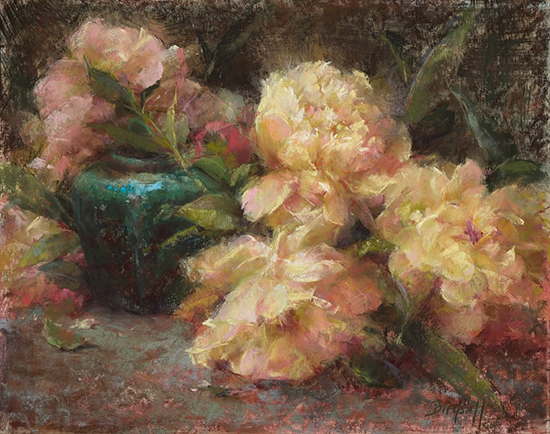
Floral Still Life 11 x 14″ Pastel
As a plein air painter, I used to have both pastels and oils in my car and two easels. I remember when I put the two easels side by side, each with a different medium. When the sun was out, I’d paint in one medium. When it went behind a cloud, I painted with the other. I paint more often in oil now, but I still do pastel. I like the freedom of being able to work in both mediums.
I love both plein air and still life painting. It is truly “all about the light”. I have a glorious north light window in my (converted barn) studio which gives my paintings a feeling of softness and possibly romanticism. I look for the play of light and the gentle way it makes the edges disappear and meld together. I often think of light as the melody leading us through the painting.
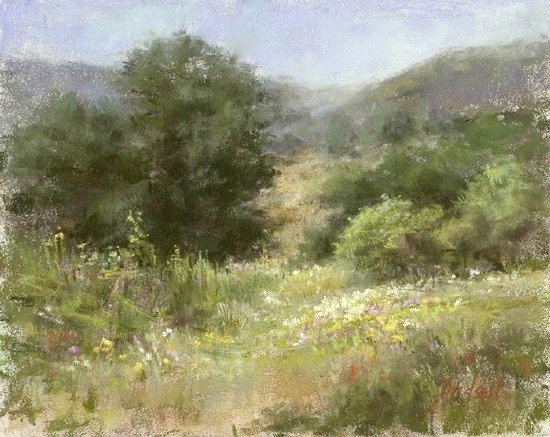
California Spring 8 x 10″ Pastel
How did your time spent in London inform your work? Where else have you traveled and painted that was particularly inspirational to you?
I’ve had wonderful opportunities to travel, not only from having lived in London for five years while I studied, but also through teaching international workshops. I think because I started with the muted English light, it has affected how I see and paint things. Recently I have had the opportunity to spend a lot of time in Rome. I find the sunlight and humidity there create a very different atmosphere which affects the colors.
Would you tell us about your process and your materials?
I can honestly say that I fall in love with my subjects and find them awe-inspiring! How does the color in nature even exist? Where does that texture come from, or the transparency? Everything I paint is live or comes from nature. I feel like my subjects whisper, ”Hey! Over here!! Paint me!!!!!”. Sometimes it is the twist and turn of a branch or stem, sometimes the wilt of a tired flower. I create relationships and stories in my mind about how my subjects relate to each other. Years ago, I painted two apples nestled in a white cloth. I titled it “Happily Married”. I think that was the beginning of my recognizing relationships between things. Flowers may lovingly gaze at each other or turn away in distress. Tree branches may reach out to each other or look longingly up a stream. I know it may sound whimsical but that is what inspires me. I have nothing against working from photographs, but I don’t relate to them in the same way. I always start from life. I take reference photos but seldom use them because I can usually substitute another flower or leaf or fruit or whatever and it will be close enough or will give me new energy in the painting. But if I have established a personal relationship with my subject, then photos could be used as a supplement.
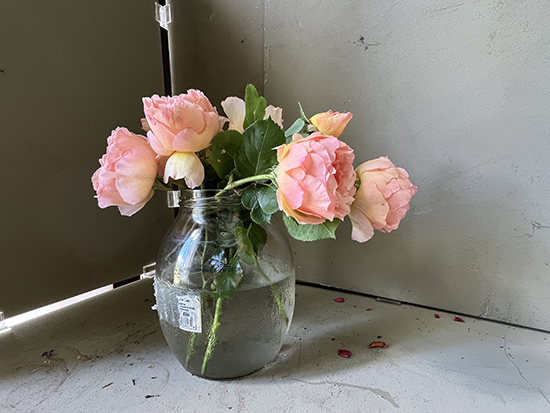
Photograph of Set-Up for Roses Oil Painting
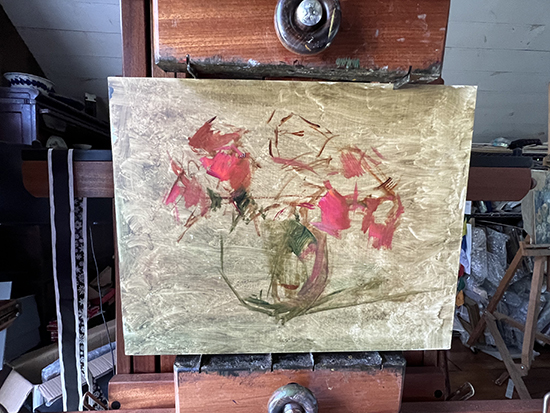
Block-In for Roses Oil Painting
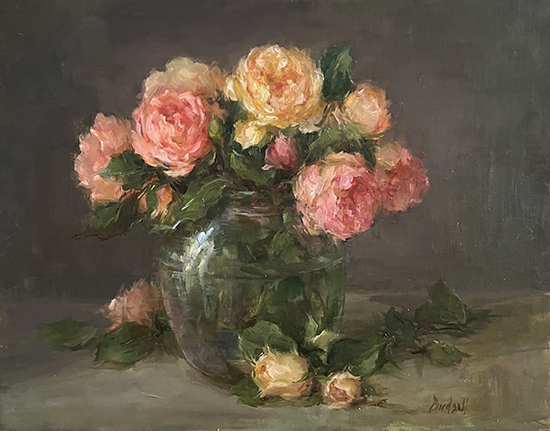
Roses 11 x 14″ Oil
My favorite brands of pastels and paints are Holbein. I use Terry Ludwig and Great American as my soft pastels. Holbein makes a set of 24 colors that is based on Richard Schmid’s color charts from his book Alla Prima. I do a lot of layering or glazing. I like showing students how you can glaze/layer an almost unlimited amount of color. The Holbein pastels are dense and are much harder to break if they fall. I under-paint with alcohol and challenge myself to see how many layers I can add. I save my soft pastels for the darkest darks and the lightest lights.
The Holbein oil paints are consistent and are my favorite brand. I enjoy the density they have and the pure color. I use Gamblin Galkyd Gel as a medium. Michael Harding has some beautiful reds and purples!
My basic palette is the color chart from Alla Prima, Everything I Know About Painting by Richard Schmid. They are:
Titanium White, Cadmium Lemon, Cadmium Yellow Light, Cadmium Yellow Deep, Yellow Ochre Pale Natural, Cadmium Red, Terra Rosa, Alizarin Crimson, Transparent Oxide Red, Viridian Green, Cobalt Blue Light, Ultramarine Blue Deep.
I also like Transparent Yellow Oxide, Transparent Brown Oxide and Indian Yellow. If I am working with very colorful subject matter, I will add to my palette accordingly. I have lots of fun colors that I use “sometimes”.
I like to paint on a linen panel. I think it comes from working with pastels on a solid surface. I use Raymar L64 for the bulk of my studio paintings. Multimedia Board makes a very lightweight Claussens board that is great for plein air.
My brushes are all from Rosemary and Co. I love the mother and daughter team and Raymar is also Mom and daughter.
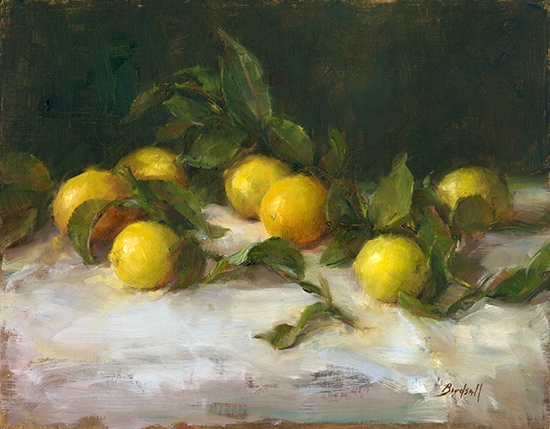
Lemons and Leaves 11 x 14″ Oil
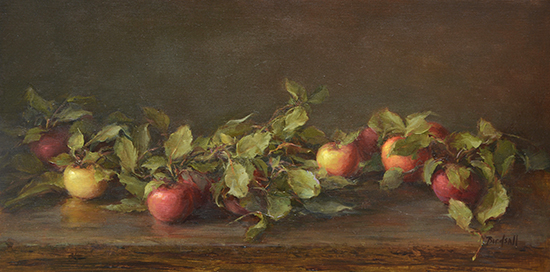
Apples 10 x 20″ Oil
Are you teaching workshops again?
I am teaching workshops in person again! I really missed having discussions in person with my students. I feel like I can be much more helpful when we can see what each other is doing. In January, 2023, I will be back at the Scottsdale Artist School which will be the first time in four years.
Any words of wisdom you might give to beginning artists?
Painting isn’t easy but it is worth every moment. My advice is to stick with it and do not compare yourself to anyone else. You can only do what you are doing when you are doing it. It is really a matter of putting in the paint miles. Find good teachers that paint the way you would like to paint and practice, practice, practice. It is also helpful to find others to paint with or give you feedback. They can be at different levels but sometimes a fresh eye can make all of the difference.
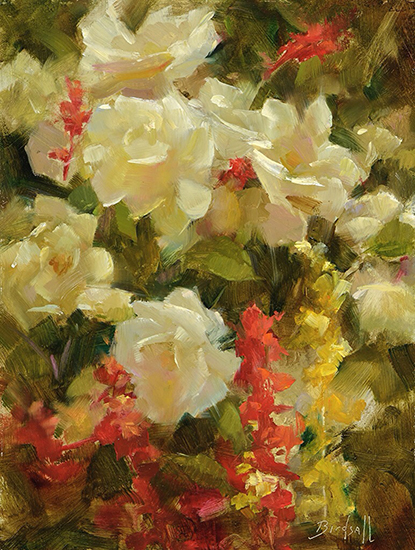
Sunlit 12 x 9″ Oil
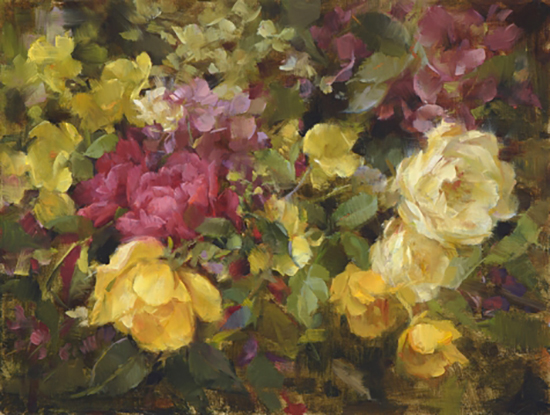
Lonnie’s Garden 11 x 14″ Oil
One of our favorite questions—just for fun, if you could sit down and have a long conversation over dinner with an artist from the past, who would you choose, and why?
I would love to have another conversation with Richard Schmid. I would like to ask him some questions about his paintings and some of the things he told us. Many of the things he told us were over my head at the time. I thought I would have more time to ask him. . .
I’d like to talk to Sorolla about his sunlight, Sargent about his brushstrokes, and Rembrandt, about light, texture and value. There are way too many past artists I would like to talk to.
![]()
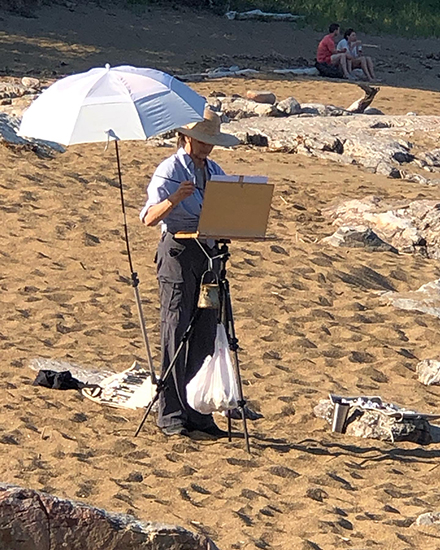
To see more of Stephanie Birdsall’s paintings,
go to:
https://www.stephaniebirdsall.com
All work copyright Stephanie Birdsall
Copyright Hulsey Trusty Designs, L.L.C. (except where noted). All rights reserved.

